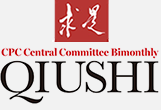The People's Congress System Is an Inevitable Outcome of History
On its founding in 1921, the CPC made it its mission to seek happiness for the Chinese people and rejuvenation for the Chinese nation. On the basis of integrating the basic tenets of Marxism with China's specific realities and the best of its traditional culture, it made tireless experiments and protracted practical efforts to create a people's democratic government and ensure that the people run the country.
Indeed, the very first program adopted by the CPC at its First National Congress in July 1921 clearly stated, "The Party recognizes the Soviet management system and organizes workers, peasants, and soldiers." During the Great Revolution (1924–1927), the CPC led the worker and peasant movements, establishing strike committees and city councils in cities and peasant associations in rural areas. These efforts marked its first attempts to establish political power.
During the Agrarian Revolution (1927–1937), revolutionary base areas established the system of worker, peasant, and soldier congresses, which resembled the basic form of the subsequent people's congress system. During the War of Resistance Against Japanese Aggression (1931–1945), a government based on a national united front against Japanese aggression was established, and the Shaanxi-Gansu-Ningxia Border Region implemented a representative assembly system based on the three-thirds principle (according to which Communist Party members, non-CPC progressives, and middle-of-the-roaders each filled a third of the official posts).
These experiments led the CPC to propose the basic idea of adopting a system of people's congresses.
In January 1940, Mao Zedong pointed out in his essay "On New Democracy" that "China may now adopt a system of people's congresses, from the national people's congress down to the provincial, county, district, and township people's congresses, with all levels electing their respective governmental bodies."
In "On Coalition Government," published in April 1945, he further stated, "The organizational principle of the new-democratic state should be democratic centralism, with the people's congresses determining the major policies and electing the governments at the various levels."
During the War of Liberation (1946–1949), people's representative conferences were successively held in all liberated areas, serving as prototypes in preparation for the establishment of people's congresses.
In September 1949, the first plenary session of the Chinese People's Political Consultative Conference (CPPCC) adopted the Common Program of the CPPCC, which held the status of an interim constitution. At the meeting, it was solemnly declared that New China would implement the people's congress system.
The first session of the First National People's Congress was held in September 1954. At the session, the inaugural Constitution of the People's Republic of China (PRC) was adopted, formally making the people's congress system the foundational political system of the state. This was a landmark event in the political development of China and even that of the world.
Thanks to 70 years of consolidation, improvement, and development since then, China's system of people's congresses is now more mature and well-defined. It has taken deep root in our country and become an integral part of Chinese socialism.
Editor: Zhang Xian
























